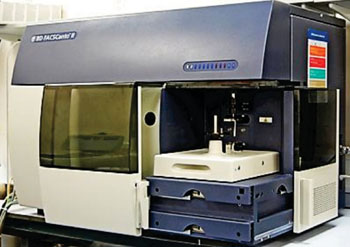Flow Cytometry Simultaneously Detects Immune Complexes Attached to Erythrocytes
By LabMedica International staff writers
Posted on 01 Jul 2015
Immune complexes attached to erythrocyte membrane are involved in autoimmune hemolytic anemia (AIHA) pathogenesis and currently, direct antiglobulin test (DAT) is used for AIHA diagnosis, but its performance can vary.Posted on 01 Jul 2015
Flow cytometry allows the analysis of multiple parameters and simultaneous detection that would be useful for AIHA diagnosis and it could help to elucidate some of the pathogenic mechanisms of this disease including the loss of erythrocytes which produces functional impairment of the aerobic metabolism causing hypoxia, tissue damage, and necrosis that can result in multi-organ failure.

Image: The fluorescent activated cell sorter FACSCanto II flow cytometer (Photo courtesy of BD Bioscience).
Scientists at the Universidad de los Andes (Bogotá, Colombia) performed a study with a total of 24 individuals divided into three groups. A control group of 10 healthy volunteers without anemia or other systemic diseases; a group of five control patients diagnosed with medical conditions (tumor or autoimmune) that predisposed them to AIHA; and a group of nine patients with AIHA diagnosis. The study was carried out between 2011 and 2013 and the enrollees were between 18 and 75 years old.
The team standardized a procedure for assessing independent or simultaneous immunoglobulin G (IgG), IgM, IgA immune complexes and complement fragment C3d, which were detected using secondary antibodies. The protocol developed was applied to blood samples of patients with AIHA, individuals at risk of developing the disease, and healthy controls. At least 2 × 104 cells were recorded in a FACSCanto II cytometer (BD Bioscience; San Jose, CA, USA) gated on the erythrocytes population.
In the AIHA group, all were positive for C3d, seven for IgG, four for IgA, and one for IgM. Two AIHA patients that were negative for DAT-IgG and C3d were positive for C3d by flow cytometry. Hemoglobin and hematocrit levels were lower in AIHA patients compared with the other groups. No differences in hemoglobin and hematocrit levels were found between healthy donors and patients predisposed to AIHA.
The authors concluded that flow cytometry is a consistent method for identifying the presence of IgG, IgM, IgA immune complexes and C3d attached to erythrocytes and can be helpful for understanding the mechanisms involved in AIHA pathogenesis. The study was published in the June 2015 issue of the International Journal of Laboratory Hematology.
Related Links:
Universidad de los Andes
BD Bioscience













